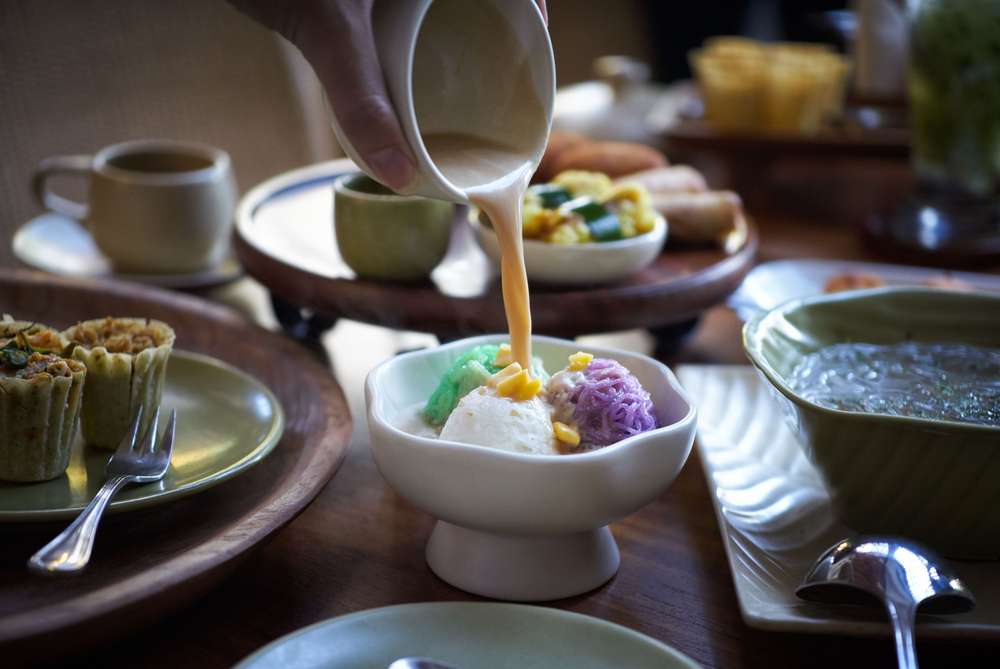
- »
- Professional Certification
- » Peranakan
Peranakan
Flavours & Flavorings
Mise-en-place
Principle Of Cooking
Fundamental Of Dry Heat Method 1
Flavours & Flavorings
Fundamental Of Moist Heat Method
Funtamental Of Combi-heat Method
Salad & Dressing
Stock & Soup
Meat & Poutlry
Fish & Shellfish
Vegetables
Rice & Noodles
Fermentation & Pickling
One Meal
High Tea
Dessert
Festivals & Ceremonies
Festivals & Ceremonies
Final Assessment
Progress
Asian Peranakan History
Asian Peranakans: A Historical Background
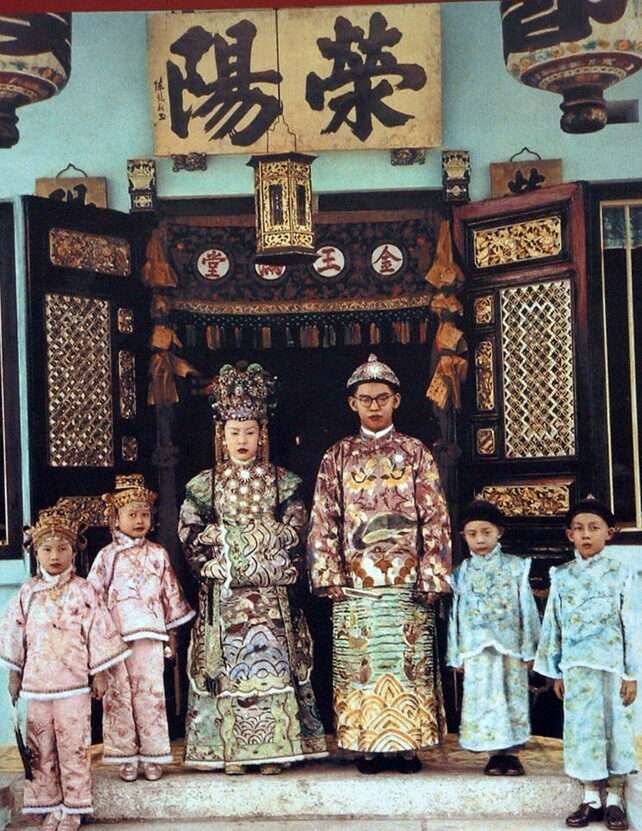
The Asian Peranakan: ‘Asian’ is a familiar enough term to most, but what of ‘Peranakan’? In its simplest form, the Peranakans are a people in South-East Asia, who have a culture that is a blend of influences from several ethnic and regional cultures, akin to a spice mix.
The word ‘Peranakan’ is derived from the Malay/Indonesian word ‘anak’ which means ‘child’, and specifically refers to the descendants of intermarriage between an indigenous person from the Malay Archipelago and an immigrant (usually Chinese or Indian).
The exact time period in which the Peranakan melting pot began to bubble is a matter of debate, but these traders are recorded as settling in the coastal towns of what is now Malaysia as well as Java and Sumatra as early as the 14th century. They emerge distinctly in the 16th and 17th centuries as descendants of the early Chinese and Indian immigrants who settled in the Malay Archipelago and took native Malay women as wives or concubines.
The earliest to arrive were the South Indians (generally from Tamil Nadu) who settled in the Malacca Sultanate in the 15th century, marrying local wives of Malay or Chinese descent, giving rise to the Chetti Malacca community, notable for their eclectic mix of Indian, Chinese, and Malay heritages. South Chinese (Hokkiens from Fujian, Cantonese, Hakkas and Teochews from Canton) from Ming Dynasty China (14th to 17th centuries) did the same, giving us the Peranakan Chinese, also called Baba or Nyonya (more will be said about this later). Similar intermarriages happened with Arabs and Thais along the trade routes. Communities were to be found at Malacca and Penang in Malaya, Singapore, Medan and Bandung in the Indonesian archipelago, in Southern Thailand at Phuket and Ranong, and even as far off as the Philippines, Burma, and Macao.
These Malay wives ran their households, as was traditional for Asian societies, with their native customs and mores. It was inevitable that these Malay wives who ruled the kitchen would have initially cooked their own dishes, but adapted with Chinese and Indian elements, and similarly cooked Chinese and Indian dishes with their own distinctly local twists.
With the arrival of the Portuguese, Dutch, Spanish, and eventually British colonial powers in South-East Asia, the Peranakans, who by this time were very much a local community, eagerly experimented with and embraced new influences from the lands now more interconnected – Thailand, Burma (now Myanmar), Britain, Holland, Spain, and Portugal.
Speaking mostly Baba Malay at home, a unique creole dialect of the Malay language peppered with words from Chinese and other languages, the Peranakans, now also referred to as the ‘Straits born’ after the British gave the name ‘Straits Settlements’ to the grouping of Malacca, Penang, and Singapore, often sent their children to the newly opened English and Dutch schools, meaning that later generations spoke fluent English or Dutch. This led to the Peranakans being perceived as racially neutral. As such, they were uniquely placed to be traders and middlemen between not only the various Asian communities, but also with the British and Dutch.
With the withdrawal of the colonial powers and rise of the South-East Asian nation-states, the mixed heritage of the Peranakan peoples has often been difficult to categorise in what are sometimes sharply drawn definitions of race and ethnicity. While Peranakan language and culture has receded in some places, it is seeing a revival in others, and enthusiastic efforts to preserve and celebrate them have borne fruit. The story of the Peranakan peoples, a unique and colourful multi-cultural mélange, has always been marked by openness to adapt and reinvent, and with the increased pace of globalisation, may yet have many more interesting chapters to be written.
Where are the Asian Peranakans?

South-East Asia has always been a crossroads for maritime trade and commerce, and the earliest records of Indian influence in the region date to the period of the Indianised Hindu-Buddhist kingdoms as early as the 4th century, first in Java and Sumatra, and then in the Indo-China region. Chinese records indicate that Chinese began settling in the Malay Archipelago as early as the 10th century, but a large influx did not occur until the Ming emperors reopened Chinese-Malay trade relations in the 15th century. Did significant intermarriage occur in the earlier periods? Unfortunately historical records do not indicate.
The first reliable accounts of the Peranakan peoples as a distinct community come from the Malacca Sultanate (13th to 16th centuries), which was a fabulously rich trading port, with a sizable and influential population of Tamil traders from South India. The arrival of the Chinese to the Malacca Sultanate is as much a matter of legend as it is of historical fact. Malacca was a vassal state of Ming China, we know that the eunuch Admiral Cheng Ho (Zheng He) visited Malacca during his expeditions. Local legends tell that a princess, Hang Li Po, was sent as a bride by the Ming Emperor to the Malacca sultan and her retinue included some 500 Chinese junior nobles and servants, who all settled in Malacca, giving rise to the Peranakan Chinese.
The coming of the British and Dutch to South-East Asia brought not only new industries, but also brought the Peranakans to new places. British rule in Malaya brought the Peranakans to Singapore and Penang. Those in Dutch-controlled areas spread to Bandung, Batavia (now Jakarta), Medan, Tanggerang, and various other places in Java, Sumatra, and Borneo (now Kalimantan). Indentured workers from China also came to these places, where the majority married local slave wives of Javanese, Sumatran, Bugis, Batak, Balinese, or Nias origin.
The Peranakan populations of all these places were fluid and tightly knit, and migration was commonplace, with the result that there was a high degree of cultural similarity between the Peranakans of various localities in the region of what is now Malaysia, Indonesia, and Singapore. Communities also hail from the Philippines, Thailand, Myanmar and Macao.
Also Known As Baba Nyonya
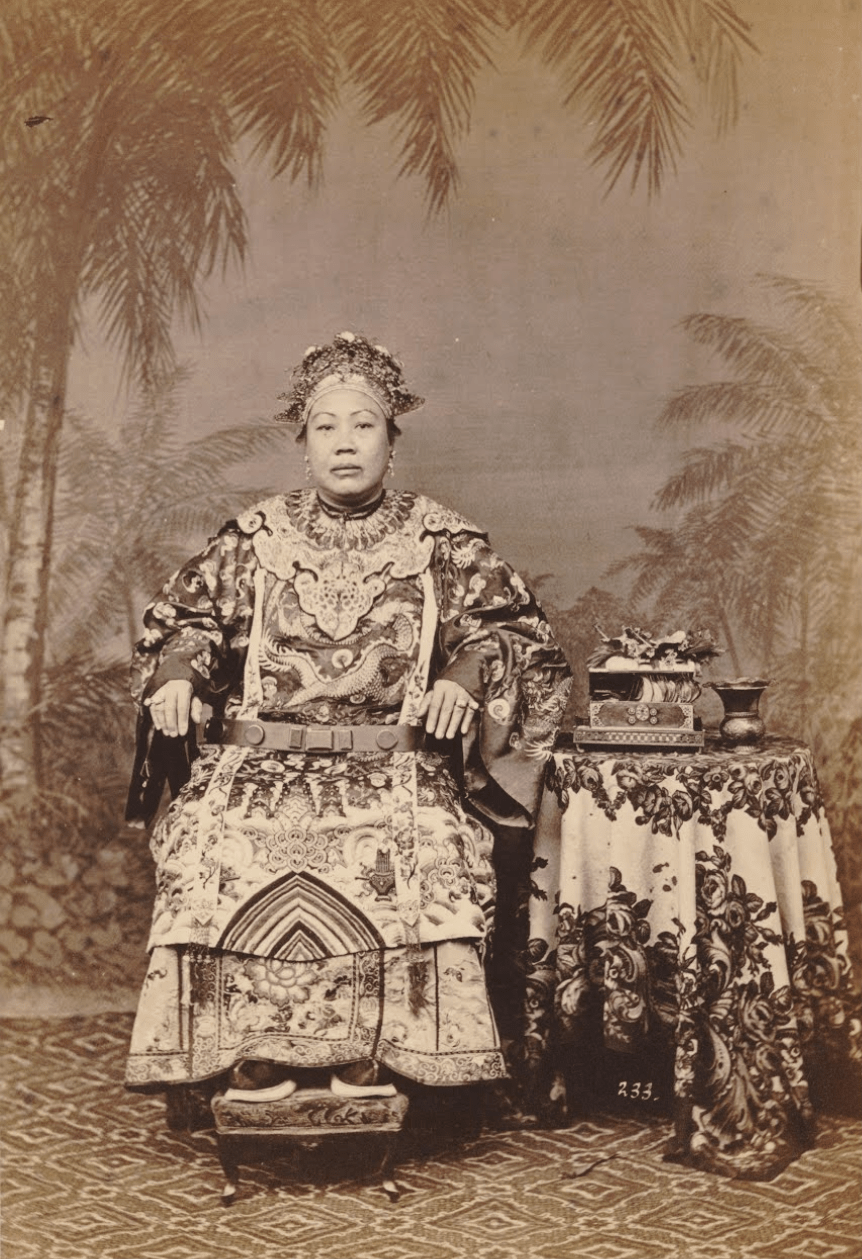
The largest group of Asian Peranakans are the Peranakan Chinese, primarily of mixed Chinese heritage. This group is also known as ‘Baba’ or ‘Nyonya’. What do these words mean, and whence have they come?
Peranakan Chinese men are referred to as ‘Baba’, originally a Persian-Hindi word meaning ‘father’, ‘grandfather’, or ‘sir’, and was used by Malay speakers as a term of endearment for grandfathers. Peranakan Chinese women are correspondingly ‘Nyonya’, however this term comes not from Persian-Hindi, but from Portuguese! ‘Lady’ in Portuguese is ‘donha’ (compare Spanish ‘doña’ and Italian ‘donna’), and Malacca was a Portuguese colony from 1511-1641, giving the word ample time to ‘go native’ in the region.
The two terms are often used interchangeably when referring to aspects of Asian Peranakan culture, but things traditionally deemed women’s work, such as embroidery and cooking, were usually called Nyonya.
‘Straits Chinese’ is a term only used for those born in or living in the British colonial construct of the Straits Settlements. ‘Baba-Nyonya’ generally only refers to those with the hybrid Chinese heritage and culture.
Asian Peranakans of the Region

As members of the mercantile class, the Asian Peranakans moved and migrated to places with opportunities around the Straits Settlements of Malacca, Penang, and Singapore. Families in all three of these places were often also related by intermarriage, facilitating business links built on the networks of relations and friends.
In addition, the emphasis on Western education meant that Asian Peranakans were particularly employable in the British civil service and as middlemen. Postings to various places in the Straits Settlements and other parts of British Malaya often resulted in civil servants moving their immediate families to new locations, widely planting Asian Peranakan communities where none had existed before. Craftsmen and artisans were also in demand all over, and their populations similarly followed regional demand.
The same process happened with the Asian Peranakans in the Dutch East Indies (now Indonesia). Both places also received large numbers of workers for the new industries of mining, agriculture, hospitality, and restaurants.
Where Did Asian Peranakans Settle?

Trade and commerce, civil service employment, and the demand for artisans brought Asian Peranakans to various places throughout South-East Asia.
In the Dutch East Indies, Asian Peranakans are found particularly at Bandung and Batavia in central and east Java, at Medan and the Bangka Belitung islands along the western coast of Sumatra, the Riau Archipelago, western Borneo, as well as Macassar and other places important for trade and colonial administration in Dutch-ruled Indonesia.
In Malaysia, apart from the oldest communities in Malacca and Penang, notable communities may be found in Kuala Lumpur and most major cities. Singapore, once part of Malaysia, also has a significant Peranakan population with a thriving culture.
The Chinoys or Mestizos of the Philippines, being the descendants of intermarriage between the Chinese and natives in the Spanish colonial period, may well be counted as Peranakans.
Thailand also has its Thai-Chinese Asian Peranakan community, centred on Phuket Island and Ranong, both in the south west coast, along the Andaman sea. Peranakans were also to be found in Hat Yai, a city in Southern Thailand just over the border with Malaysia’s Kelantan State. These are the result of migrations in the 19th century as Peranakan merchants sought to expand their spheres of influence.
Asian Peranakans and their influences are found as far away as Burma (Myanmar) and Macao. Burma’s Peranakan community has its origins in rich overseas Chinese in Rangoon (now Yangon) marrying wives from Penang’s Peranakan community, giving rise to a local population with close ties to the Penang, while Macao’s cultural tapestry includes foods with distinctly South-East Asian elements and even their local Patua, a Portuguese creole, retains words of Malay origin.
This course will focus on Asian Peranakan food as found in Singapore, which exhibits a distinctly local take on the multicultural shared culinary heritage of Asian Peranakans all across South-East Asia.
The Effect of Migration on Asian Peranakan Culture
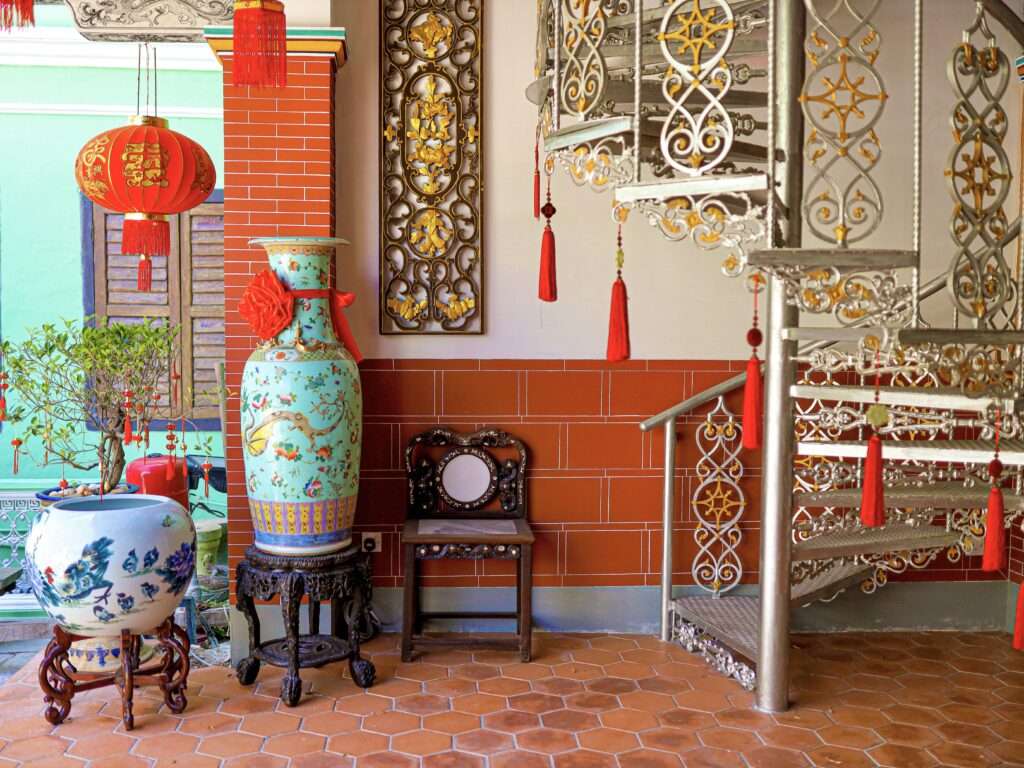
While there are many shared elements of culture across the wide geographical area in which Asian Peranakans may be found, such as the wearing of the kebaya and beaded slippers by ladies, use of a mixed creole language, fusion cuisine, and other hybrid customs, true to their spirit of adaptation, Asian Peranakans have always taken local elements and added them to their multi-cultural heritage.
The Chetti Malacca (Peranakan Indian) culture is exemplified in their language – a seamless blend of Indian, Malay, and Chinese influence. While predominantly Hindu, they too have adopted the Malay language, even using the Chetti creole for Hindu prayers which other Hindus perform in Sanskrit. Their dress reflects Tamil, Bugis, Acehnese, Javanese, and Bugis influences. Their food shows a strong Indian sensibility in their use of spices and flavours.
The Jawi Peranakans, once a major community in the Malay world, were Straits-born Muslims of mixed Indian (especially Tamil) and Malay parentage but have now largely assimilated into Malay society. They developed a fluid identity vis-à-vis their host society, liberally adopting Malay language and customs, while retaining their preference for southern Indian cuisine and dress. As with other Peranakan subcultures, oscillating between their hybrid cultural identities was partly a source of their communal strength.
Baba-Nyonyas exhibit much variation across the spread, with those of Penang, Phuket, and Rangoon having notably Thai elements, particularly in their use of lemongrass and sour-sweet flavours in cooking. Thai Peranakans, naturally, have a much stronger Thai influence in their culture, mostly speaking Thai in modern times, but retain their architecture, family customs, and cuisine, albeit with a distinctive Thai twist.
Despite the Thai culinary elements, the Penang Peranakans speak mostly Hokkien, in contrast to those of Malacca and Singapore, who speak Baba Malay (and English in the present day).
The Asian Peranakans of Indonesia fit in well, as Indonesia has long been a place of many cultures that influence other and cross-fertilise each other. A greater use of Indonesian batik in fashion, a predominance of Indonesian flavours in cooking, and a vocabulary containing words from the local languages are marks of inculturation. Peranakan culture has influenced even Indonesian mainstream culture itself, with many food items coming from Peranakan roots. The Indonesian/Malay word ‘kuih’ (also spelt ‘kueh’ or kue’), meaning a bite-sized dessert or snack food, is of Hokkien/Teochew origin.
What Did Asian Peranakans Speak?
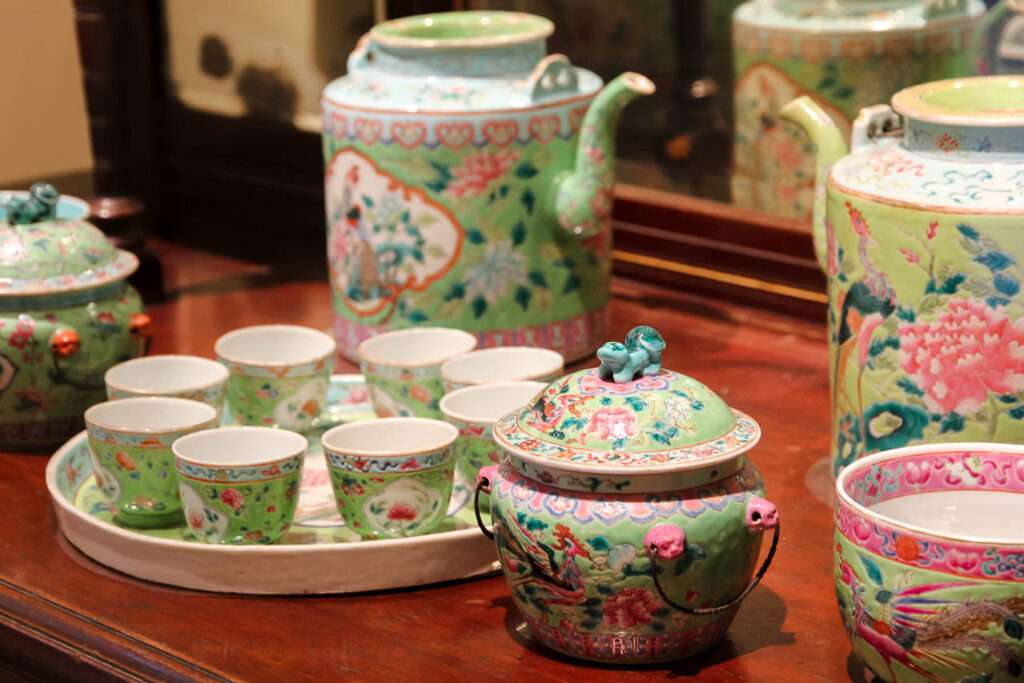
As we have mentioned, the culture of the Asian Peranakans is very much a product of the interactions between migrant peoples and native peoples.
An environment with influences of European, various Chinese, Malay, and Indian cultures have produced a hybrid and varied culture, which comfortably assimilates and draws strength from its multicultural sources.
The language spoken at home by Asian Peranakans is, like the rest of their culture, a hybrid. The early Chinese husbands, in addition to their native languages, would have spoken basic Malay to their native wives, and the wives in turn would have learned bits of the Chinese languages. Children growing up in such an environment would have absorbed both, switching comfortably between languages. This resulted in a creole based largely on Malay, peppered with varying amounts of the South Chinese languages depending on the location.
Just like their food culture, the Asian Peranakan patois, originally an informal register borne of necessity and spoken only at home, became a common element linking an entire community and a mark of identity.
The Asian Peranakans of Malacca and Singapore traditionally spoke Baba Malay, which is a subvariety of Malay that was originally a group of pidgins based on Chinese grammar with mostly Malay vocabulary. A notable exception is the Chetti Malacca community, which speaks Baba Malay with a larger admixture of Tamil words as befits their South Indian roots.
Unfortunately, the Baba Malay language is endangered, with the younger generations speaking mostly English and Mandarin as a result of the push towards Western-style education and the Speak Mandarin campaign. Nevertheless, there has been a revival of the language in recent decades, with classes and cultural activities seeing a surge of interest.
On the other hand, the Asian Peranakans of Penang have largely been assimilated and adopted the Penang Hokkien the larger Chinese population, although Penang Hokkien itself has not remained unchanged by this, as the large number of Malay loan-words in Penang Hokkien will show. The dominance of Penang Hokkien has also declined in recent years, with younger generations of Asian Peranakans speaking mostly English and Mandarin.
Just like their cousins in Malacca, Singapore, and Penang, the Asian Peranakans of Indonesia, the Philippines, Burma, and Thailand, speak similar blends of the local speech enriched by elements of Chinese and other languages. All these variants of Asian Peranakan lingo have been, to varying extents, seen a decline due to the language standardisation of Chinese and Malay, with Baba Malay difficult to categorize into either. Nevertheless, Asian Peranakans retain a deep emotional connexion to the language, as it provides a sense of familiar ‘rootedness’, just as to their food. How will the linguistic map change over the next few centuries? Only time will tell, as the Asian Peranakan culture has always always been accepting of new influences and making them its own, as much in speech as in cooking.
Different Tongues in Different Places
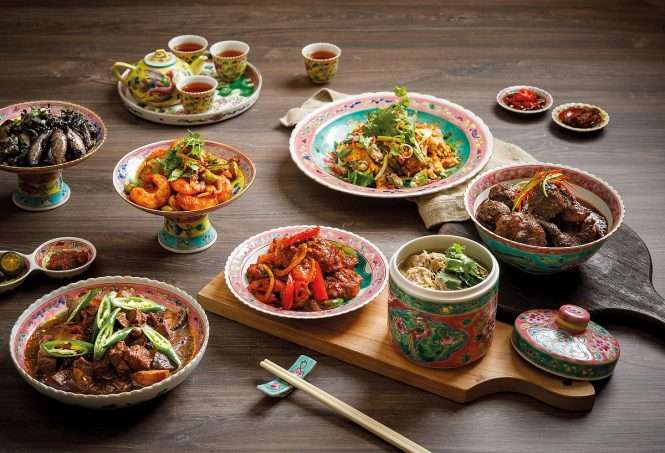
As the original fusion culture of South-East Asia, the Asian Peranakans have absorbed the local culture wherever they have settled. As such, both the language and culture of each subgroup of the Asian Peranakan family will differ from place to place, sometimes in subtle ways, and sometimes in not so subtle ways.
The Chetti Malacca speak Baba Malay with a larger admixture of Tamil words, and are generally of the Hindu faith, and their Hindu rituals are conducted in Baba Malay. The other Asian Peranakans tend to follow either traditional Chinese religions such as Buddhism and Taoism, or have adopted forms of Christianity.
In line with the tradition of assimilating the local culture and language, the Asian Peranakans of Burma, Indonesia, and Thailand have similarly adopted elements of the majority culture around them. Asian Peranakans of Indonesia speak a language with an abundant presence of Javanese words, and their cooking naturally also includes Javanese dishes with a Peranakan twist, or the use of native Javanese elements in the dishes shared with other Peranakans of the region. The Thai Asian Peranakans likewise have been influenced by the majority Thai culture, so their speech contains a Thai element and their food is has a distinct preference for sour-sweet flavours, a preference also reflected in the food of the Penang Peranakans, who are geographically midway between Thailand and Malacca.
What Did Traditional Asian Peranakans Households Use?
Featuring
- Table Chopsticks
- Forks And Spoons
- Chinese Soup Spoons
- Wok
- Steaming Baskets
- Lesong (Mortar And Pestle)
- Batu Giling (Grinding Stone)
- Batu Bo (Stone Mill)
- Blangah (Indian Clay Pot)
- Cleaver/chopper
- Board With Spikes For Grating
- Cooking Chopsticks
- Chopping Board
- Tengkat (Tiffin Carrier)
- Tanggok (Bamboo Sieve)
- Assorted Moulds For Kuih
What Festivals Do Asian Peranakans Celebrate?
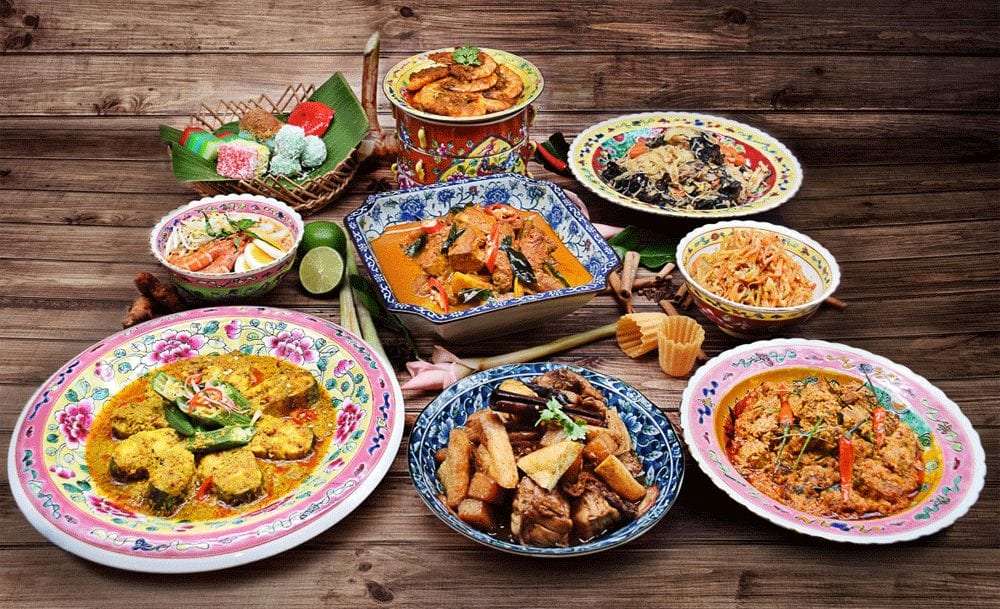
While Asian Peranakans, coming from a multi-ethnic background, have adopted elements of various cultures, they generally follow one of these elements more closely. For the majority of them, this is the Chinese tradition. As historically Chinese-leaning, most Asian Peranakans are of the Buddhist and Taoist faiths in the syncretic manner traditional to most Chinese families. As such, they will be found to mark almost all the traditional Chinese festivals. Even those who have adopted Christianity generally observe the cultural aspects of these festivals, without the religious elements.
Chiefest among these festivals is, of course, the Chinese New Year, an occasion for giving thanks for the blessings of the previous year, praying for the good fortune of the previous year to continue and new blessings from the deities. It is a family holiday and an occasion for gatherings of extended family and, of course, tasty seasonal dishes. The weeks leading up to the New Year are filled with busy house cleaning and decoration, the making of new clothes, gift exchanges, the cooking of seasonal specialties and baking of snacks. The eve of Chinese New Year is time of the reunion dinner, and Chinese traditionally try to make it home, no matter how far away they are, for this meal at which traditional dishes are served. The first day of the New Year is marked by the offering of incense at the family altar or a visit to the temple to pray for good luck. A custom has grown up among the Christian Peranakans to attend a special church service marking the festival on the morning of this first day. Then comes a ritual where younger members of the family kneel or bow and pay their respects to elder members in turn, wishing them long life and good health. This is followed by the elders giving red packets containing cash to younger members of the family. Families may send gifts of seasonal snacks to their Malay and Indian neighbours and friends, in return for the gift of similar snacks during their own festivals. Some families have a custom of visiting graves of departed family on the first day, to honour them with gifts of fruit and incense, a custom adopted from their Muslim Malay neighbours who visit family graves on the first day of Hari Raya (Eid ul-Fitr) to offer flowers, prayers, and scented water. Family visits to the homes of friends and relatives then take place according to a complicated system of rank and order, generally with elder members of the family staying home and younger members going out to make visits. The whole thing lasts fourteen days.
The Dumpling Festival, on the fifth day of the fifth lunar month, is celebrated by Asian Peranakans as well as by Chinese. The roots of this summer festival lie in the tale of an unhappy Chinese poet’s suicide in protest of a ruler failing to implement social reform intended to benefit the poor. The poet drowned himself in a river, and the peasants threw glutinous rice dumplings into the water in an attempt to persuade the fishes and marine creatures not to eat the poet’s body. The making and eating of dumplings for this festival has become a pan-Chinese tradition, with each province and county having their own unique preferred fillings and style, albeit all wrapped in the traditional bamboo leaves. Asian Peranakan dumplings are no exception, and the Nyonya bak chang is a notable favourite in South-East Asia.
The Lantern Festival, or Mid-Autumn Festival, is also observed on the fifteenth day of the eighth lunar month. With the moon at its fullest, this is a time for evening outdoor family reunions, thanksgiving for the harvest, and prayers for continued blessings. To mark the fullness of the moon, round mooncakes are baked and consumed. The fillings of these mooncakes varies from place to place, but are generally sweet, such as lotus seed paste, yam paste, or sweet bean paste. These mooncakes are eaten with tea, to the accompaniment of music and poetry.
Joyous occasions such as births and weddings are celebrated in all cultures, and Asian Peranakan customs are among the most colourful. Births are celebrated with the distribution of special cake snacks to friends and relatives. Specific dishes with particular nutritious properties are cooked for the mother of the newborn to restore her health and build up her constitution after the travails of childbirth.
Asian Peranakan weddings are a 12-day affair, based on the traditional Chinese ceremonies, and when conducted in full, are elaborate and complex, requiring a Wedding Master and a Wedding Mistress to act as masters of ceremony and direct the rites. Food plays an important part of the rites, as the couple must ceremonially offer tea to the elders in turn, in gratitude for their upbringing, and at various times will eat specific foods with auspicious symbolic meanings, such as sweet soups and dumplings for a sweet life, lotus seed fillings for numerous offspring, and so on. A wedding feast is mandatory, and no shortcuts are allowed. Preparation of dishes begins as early as a week before the feast, and dishes were cooked slowly as a way of preserving food in an age before refrigeration. This feast is traditionally an all-day affair stretching from lunch to dinner, with seatings based on seniority and rank in the family and social order.
Chetti Malacca, being mostly Hindu, will observe most South Indian festivals. The Tamil New Year or Puthandu is marked with solemnity, with special foods and prayers being offered. The harvest festival of Pongal and Deepavali are also celebrated in ways similar to those of their Indian counterparts. The Asian Peranakans of other regions will also similarly celebrate the festivals of their lands, albeit with their own twists.
New world Peranakan
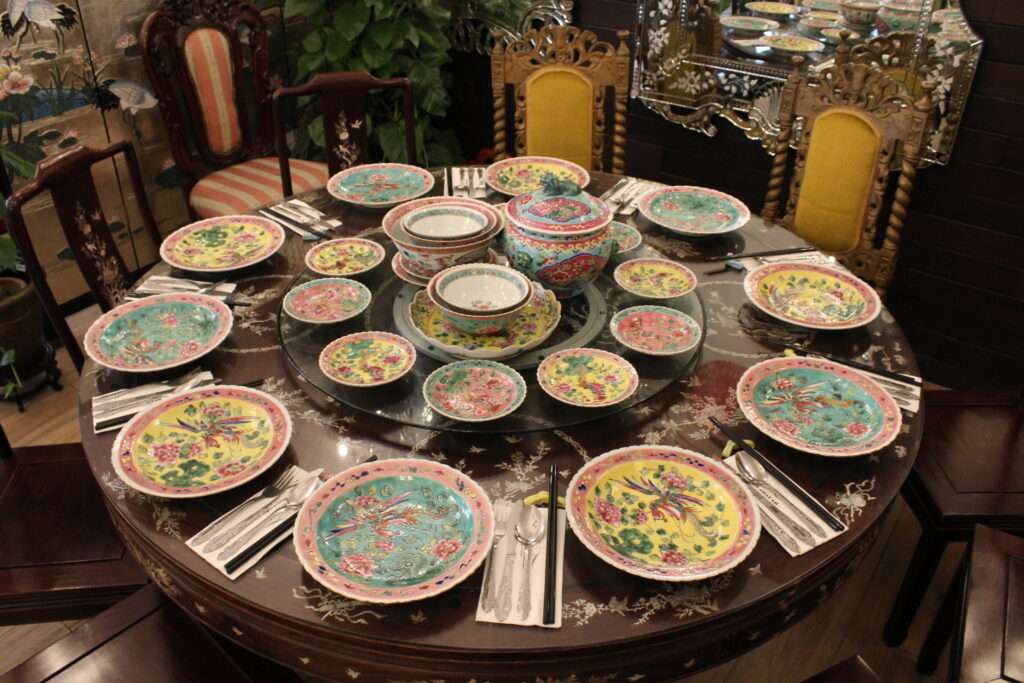
Globalisation and ‘modern’ lifestyles have had no less an impact on Asian Peranakan culture than other traditional cultures, and arguably even more.
The traditional Asian Peranakan culture is based around several generations and branches of a family living in close proximity, and the work that goes into creating the complex cuisine was traditionally shared between various members of the family. As extended families living together becomes a rarer phenomenon, the elaborate rituals, social and religious observances, and foods that mark the life of a Peranakan family have been increasingly harder to maintain in their fullness.
The long preparation processes of traditional dishes and arts and crafts such as embroidery and dressmaking, once all essential skills, have all suffered from the modern problem of lack of time. It is cheaper and easier to cook dishes with simpler preparation, and to buy ready-made dresses and embroidery.
Every savoury dish traditionally begins with the pounding of aromatic herbs and spices with a mortar and pestle, making a rempah or base mix, to which other flavours are added for various dishes. The slow laborious pounding bruises the herbs, enabling them to release their flavour in a way that is not replicable with food processors. It is said that older women would listen to the way a prospective daughter-in-law pounded her herbs in order to gauge how attentive she was to the task at hand. The lengthy preparation of peeling, pounding and grating have now given way to modern techniques intended to save time and labour. Nevertheless, many modern families, pressed for time, now rely on shortcuts such as premixed store-bought sauces and bases, which never taste the same. In the same way, the fineness of handmade crafts cannot be reproduced exactly with mechanical techniques.
Essential skills of the past have given way to modern priorities, and traditional methods once practiced daily have now become occasional indulgences for special occasions such as birthdays, births, weddings, and Chinese New Year. Peranakan culture is a product of successive ages of globalisation causing large-scale interactions between peoples and cultures. No doubt, the increased pace of globalisation will have its effect on Peranakan culture, causing it to evolve and change continuously.
Impact of Modern Life on Asian Peranakan Cuisine (15 min read)
Asian Peranakan culture, being a child of multi-cultural influences, has always been fluid and accepting of new influences and diversity. Present day life, with its demands, has changed the milieu in which Asian Peranakans find themselves. Smaller families living apart, sometimes in different cities or even countries, in comparison with the large extended households of the past has meant that many traditions and customs are no longer easily practiced.
Domestic servants are no longer as common as they were before, except in the grandest households, and even then, are unlikely to know the traditional family recipes. Modern families where both spouses work full-time jobs means that few have the time or the energy to pursue the traditional arts, particularly of the kitchen, where many dishes require long and elaborate preparation.
Yet, the modern world with its ubiquity of social media and interest in preserving fading traditions means that it is possible for minority voices to be heard quite loudly. Enthusiasts of Asian Peranakan culture have formed societies and online communities to promote and preserve aspects of their culture, ranging from language to song and dance, and of course, food. Near-universal literacy has made it possible for family traditions and recipes to be recorded, while Facebook, blogs, Twitter, Instagram, Pinterest and other forms of social media have allowed people to share and celebrate culture in ways that were unimaginable a century ago. Tourism has led to a revival of interest in traditional culture, and Asian Peranakan culture has been a poster-child for the diverse melting-pot of South-East Asia.
Asian Peranakan cuisine has found favour with cooks both amateur and professional as globalisation has made it easier to obtain authentic ingredients and recipes, and as interest in combining traditional techniques and elements from various cultures rises, Asian Peranakan cuisine, being the original fusion, is taking an increasingly important role on the global centrestage.
Forum Discussion with Chef Trainer: ‘What Makes Asian Peranakan Culture and Food Distinctive?’
What are these Asian Peranakan items? Review the Video and Match the pictures with the descriptions.
- steaming baskets
- lesong (mortar and pestle)
- batu giling (grinding stone)
- batu bo (stone mill)
- blangah (Indian clay pot)
- cleaver/chopper
- board with spikes for grating
- tengkat (tiffin carrier)
- tanggok (bamboo sieve)
- moulds for sweet kuih












